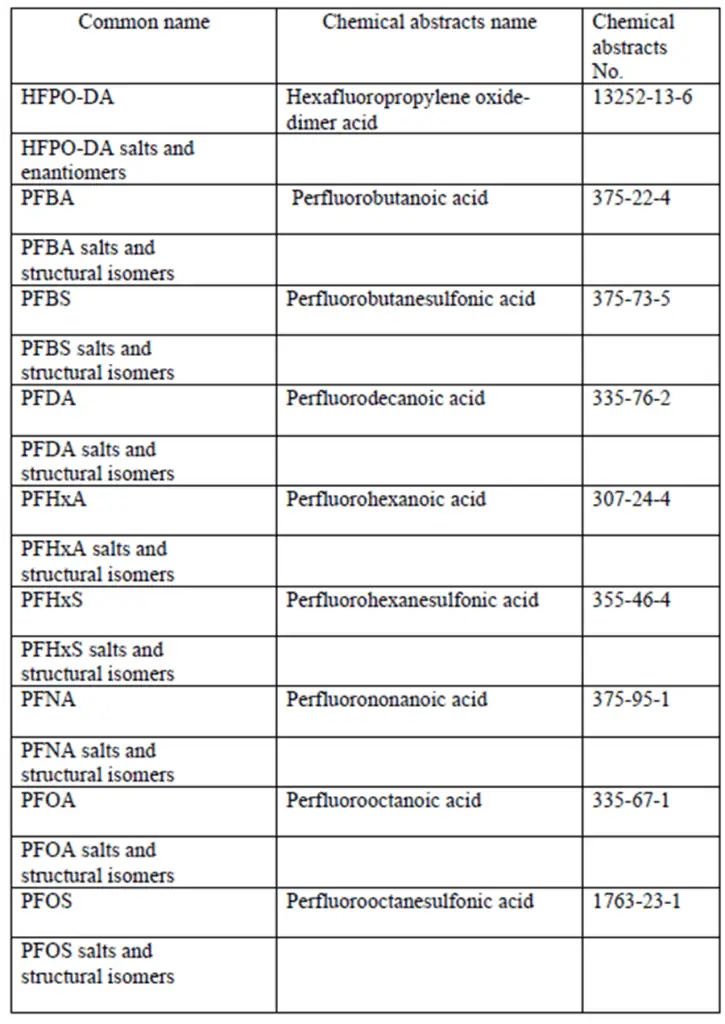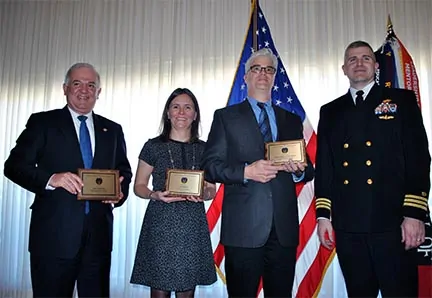

Join us April 30 – May 1, 2025, at the Mystic Lake Center in Prior Lake, MN, for the premier Recycling Association of Minnesota (RAM) and the Solid Waste Association of North America Land of Lakes Chapter annual Conference & Show in the Upper Midwest.
As a Gold Sponsor, SCS Engineers is proud to support discussions on hazardous waste, recycling, solid waste, food waste diversion, and sustainability. Attendees can earn Continuing Education Credits and take advantage of valuable networking opportunities.
Several SCS Engineers professionals will be attending—connect with us and be part of the conversation on advancing waste management and recycling solutions. We hope to see you there!
Click for more details and registration information

In response to its PFAS Strategic Roadmap, the Environmental Protection Agency (EPA) initiated two regulatory actions under the Resource Conservation and Recovery Act (RCRA) to tackle PFAS pollution. Once implemented, these measures will empower federal and state agencies with advanced tools for PFAS remediation.
The initial proposed regulation intends to designate specific PFAS as “hazardous constituents” within RCRA’s framework, making them subject to detailed scrutiny and cleanup actions at sites handling hazardous waste.
The second proposed rule aims to affirm that new contaminants, including certain PFAS that are not currently classified as “hazardous wastes” yet align with the definition of “hazardous waste” in RCRA section 1004(5), should be managed equivalently to traditional hazardous wastes in the context of corrective actions. Listing these PFAS as RCRA hazardous constituents does not make them, or the wastes containing them, RCRA hazardous wastes.

On February 8, 2024, the EPA proposed to add nine PFAS compounds to the list of “hazardous constituents” to be considered “in RCRA facility assessments and, where necessary, further investigation and cleanup through the RCRA corrective action process.” Appendix VIII to Part 261 – Hazardous Constituents shown at right.
If finalized, this hazardous constituent listing would form part of the basis for any future action the EPA may take to list these substances as hazardous waste.
EPA’s criteria for listing substances as hazardous constituents under RCRA require that they have been shown in scientific studies to have toxic, carcinogenic, mutagenic, or teratogenic effects on humans or other life forms.
Entities potentially affected by the proposed rule include hazardous waste treatment, storage, and disposal facilities (TSDFs) with solid waste management units (SWMUs) that have released or could release any of the PFAS proposed to be listed as RCRA hazardous constituents. EPA has identified 1,740 such facilities, which could be subject to additional corrective action requirements. “Waste Management and Remediation Services” had the highest number of facilities (359) with a high likelihood of handling PFAS.
The primary goal of the suggested amendment is to update 40 CFR 264.101 so that it accurately mirrors the requirements for corrective action cleanups at hazardous waste Treatment, Storage, and Disposal Facilities (TSDFs) as specified by RCRA sections 3004(u) and (v). The modifications are designed to clarify that the management of hazardous waste releases, including those not categorized as hazardous under current regulations but fitting the broader definition in RCRA section 1004(5), should adhere to the established protocols for hazardous waste under the corrective action program. Focusing on Per- and Polyfluoroalkyl Substances (PFAS), this regulatory action is a crucial part of the EPA’s PFAS Strategic Roadmap.
Should this proposed regulation be adopted, it would mean that PFAS would be specifically included as hazardous constituents to be considered during facility assessments and, where necessary, further investigation and cleanup under the RCRA corrective action process at hazardous waste TSDFs.
The proposed regulation states that “solid waste disposal facilities, such as those for municipal waste or construction and demolition debris, would not be subject to RCRA corrective action requirements unless they also function as hazardous waste TSDFs.”
Subtitle D of RCRA covers non-hazardous solid waste management, including municipal solid waste landfills, which are subject to different regulations than hazardous waste facilities (regulated under Subtitle C).
Although the recent proposal by the EPA to revise RCRA does not aim at mandating corrective actions at municipal solid waste (MSW) landfills, it sets the stage for probable future amendments under Subtitle C that might classify certain PFAS-containing waste streams, currently considered non-hazardous, as hazardous waste (e.g., listed or characteristic wastes).
While it is premature to predict the impact of future hazardous waste regulations on MSW landfills, it is appropriate to begin collecting information on PFAS waste and assessing potential effects now. Landfills that have implemented special waste review programs (for example, for non-hazardous industrial wastes like wastewater treatment sludge) are advised to expand their waste characterization efforts within these programs to include requests for data on the presence and concentration of the nine PFAS constituents highlighted in the proposed RCRA rule. Additionally, landfills without such review programs are encouraged to consider establishing them.
Additional Resources/Legislation:
About the Authors: Connect with our authors and experts at
 Jeff Marshall, PE, is a Vice President of SCS Engineers, Environmental Services Practice Leader for SCS offices in the Mid-Atlantic region, and our National Expert on Emerging Contaminants and Innovative Technologies. His four decades of experience include a diversified project engineering and management background, emphasizing environmental chemistry, hazardous materials, waste, and human health risk issues. Focus areas include environmental permitting, regulatory compliance, and hazardous materials treatment and remediation. He is a licensed professional engineer in Virginia, Maryland, West Virginia, North Carolina, and South Carolina.
Jeff Marshall, PE, is a Vice President of SCS Engineers, Environmental Services Practice Leader for SCS offices in the Mid-Atlantic region, and our National Expert on Emerging Contaminants and Innovative Technologies. His four decades of experience include a diversified project engineering and management background, emphasizing environmental chemistry, hazardous materials, waste, and human health risk issues. Focus areas include environmental permitting, regulatory compliance, and hazardous materials treatment and remediation. He is a licensed professional engineer in Virginia, Maryland, West Virginia, North Carolina, and South Carolina.
The Recycling Association of Minnesota (RAM) and the Solid Waste Association of North America Land of Lakes Chapter are hosting their annual Conference & Show April 25 & 26 at the Mystic Lake Center in Prior Lake, MN.
The RAM/SWANA Conference & Show continues to be the premier recycling and waste management conference in the Upper Midwest.
RAM/SWANA Conference topics include Hazardous Waste, Recycling, Solid Waste, Food Waste Diversion, and Sustainability. Continuing Education Credits are available, and there always are numerous networking opportunities. Several SCS Engineers professionals are attending the conference – we hope to see you there!
SCS periodically prepares Technical Bulletins to highlight items of interest to our clients and friends who have signed up to receive them. We also publish these on our website at https://www.scsengineers.com/publications/technical-bulletins/.
Our most recent Bulletin summarizes the 2020 USEPA Adds 172 PFAS Chemicals to EPCRA TRI Reporting Program. The new PFAS rule went into effect on June 22, 2020. However, the rule requires PFAS to be included in TRI reports submitted for all 2020 calendar year activity (i.e., January 1 through December 31). The deadline for submitting the 2020 TRI reports is July 1, 2021.
TRI-Covered Industries include:
SCS Engineers will continue to post timely information, resources, and presentations to keep you well informed. These include additional guidance, industry reaction, and webinars for our clients.
Contact https://www.scsengineers.com for an Environmental Engineer near you.
Proposed Amendments to the Coal Ash Regulations, Public Hearing Registration Open
EPA is proposing further amendments to the regulations governing the disposal of coal combustion residuals, commonly known as coal ash.
The proposal addresses two issues remanded by the courts back to EPA for action. EPA is proposing a modification to one of the criteria used to determine if coal ash is being beneficially used or would be considered disposal. The second proposed change is to the requirements for managing piles of coal ash. Other proposed changes include revisions to enhance public access to information.
In addition to accepting written comments on this proposal, EPA is holding two public hearings – one in person in Arlington, Virginia on October 2, 2019, and a second one that will be held virtually.
To learn more about this proposal and the public hearings, learn how to comment and register to speak or observe, visit: https://www.epa.gov/coalash/coal-ash-rule#July2019proposal.
Upcoming e-Manifest Fiscal Years 2020-2021 User Fees
EPA announced the new e-Manifest user fees for fiscal years 2020-2021 (October 1, 2019-September 30, 2021). These user fees are set based on the manifest usage and processing costs for each manifest type.
EPA encourages the hazardous waste industry to adopt fully-electronic manifesting as soon as possible so that industry members can take maximum advantage of the benefits and cost savings of electronic manifesting. However, EPA acknowledges that it will take time for industries and receiving facilities to fully transition to electronic manifests. EPA supports the wide adoption of electronic manifesting by the regulated community as soon as it is feasible.
For more information and to view the new user fees, visit https://www.epa.gov/e-manifest/e-manifest-user-fees-and-payment-information#2020fees.
Comment Period Open for Comprehensive Environmental Response, Compensation, and Liability Act (CERCLA) 108(b) Electric Power Industry Proposal
EPA is seeking public comment on a proposed rule not imposing financial responsibility requirements under CERCLA Section 108(b) for Electric Power Generation, Transportation, and Distribution facilities.
The comment period for the proposed changes is open for 60 days, through September 27, 2019. To learn more, view the proposal, and how to submit comments visit: https://www.epa.gov/superfund/proposed-action-financial-responsibility-requirements-under-cercla-section-108b-classes.
Incremental Sampling Methodology (ISM) at PCB Cleanup Sites
ISM has been shown to be a valid and effective method for determining the concentrations of contaminants, including PCBs, in heterogeneous soils when designed appropriately. This document has a brief description of ISM and provides EPA’s policy of reviewing and approving site-specific applications to use ISM at PCB cleanup sites: https://www.epa.gov/pcbs/incremental-sampling-methodology-ism-pcb-cleanup-sites.
New and Updated Pharmaceutical Frequent Questions Posted
EPA recently updated several frequent questions about the final rule establishing management standards for hazardous waste pharmaceuticals and amending the P075 listing for nicotine. Additionally, EPA added a section about the sewer ban, which was effective August 21, 2019.
Check out the frequent questions out here: https://www.epa.gov/hwgenerators/frequent-questions-about-management-standards-hazardous-waste-pharmaceuticals-and.
Use these EPA resources to learn more, or contact SCS at and we’ll help answer your questions.
The Society of American Military Engineers recognized SCS Engineers for their 15 years of service and volunteer support at the District of Columbia post this month. The award was presented by Commander Craig Clutts of the US Navy, the Outgoing DC Post President.
On hand to receive the award for SCS was John Tabella, PG, LEED AP®, National Expert for Environmental Due Diligence and for Federal Services; Heather Blake (pictured), Federal Marketing Coordinator, and Dave Hostetter, PE, LEED AP®, and CEM at SCS Engineers.

SCS Engineers has a very long track record of solving environmental and energy management, solid waste, hazardous waste, water, and air compliance challenges. Approaches we pioneered include risk-based cleanups, voluntary cleanups, accelerated investigations, presumptive and sustainable remedies, environmental management systems, energy systems, and waste minimization. These approaches are at the forefront of local and Federal environmental and energy programs today.
SCS provides professional engineering and scientific services with a focus on environmental protection and conservation of resources. Our clients come back because we find practical approaches to even the most complex environmental challenges.